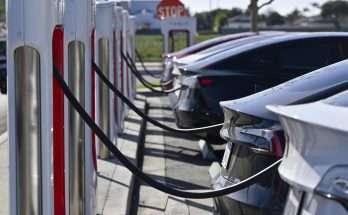
Tesla electric cars photographed in Germany on March 21, 2022. According to the International Energy Agency, electric vehicle sales are on course to hit an “all-time high” this year.
Sean Gallup | Getty Images News | Getty Images
Electric vehicle sales are on course to hit an all-time high this year, but more work is needed in other sectors to put the planet on course for net-zero emissions by 2050, according to the International Energy Agency.
In an announcement accompanying its Tracking Clean Energy Progress update, the IEA said there had been “encouraging signs of progress across a number of sectors” but cautioned that “stronger efforts” were required to put the world “on track to reach net zero emissions” by the middle of this century.
The TCEP, which is published yearly, looked at 55 parts of the energy system. Focusing on 2021, it analyzed these components’ progression when it came to hitting “key medium-term milestones by the end of this decade,” as laid out in the Paris-based organization’s net-zero pathway.
On the EV front, the IEA said global sales had doubled in 2021 to represent nearly 9% of the car market. Looking forward, 2022 was “expected to see another all-time high for electric vehicle sales, lifting them to 13% of total light duty vehicle sales globally.”
The IEA has previously stated that electric vehicle sales hit 6.6 million in 2021. In the first quarter of 2022, EV sales came to 2 million, a 75% increase compared to the first three months of 2021.
The IEA said both EVs and lighting — where more than 50% of the worldwide market is now using LED tech — were “fully on track for their 2030 milestones” in its net-zero by 2050 scenario.
Despite the outlook for EVs, the IEA separately noted that they were “not yet a global phenomenon. Sales in developing and emerging countries have been slow due to higher purchase costs and a lack of charging infrastructure availability.”
Overall, the rest of the picture is a more challenging one. The IEA noted that 23 areas were “not on track” with a further 30 deemed as needing more effort.
“Areas not on track include improving the energy efficiency of building designs, developing clean and efficient district heating, phasing out coal-fired power generation, eliminating methane flaring, shifting aviation and shipping to cleaner fuels, and making cement, chemical and steel production cleaner,” the IEA said.
The shadow of 2015’s Paris Agreement looms large over the IEA’s report. Described by the United Nations as a “legally binding international treaty on climate change,” the accord aims to “limit global warming to well below 2, preferably to 1.5 degrees Celsius, compared to pre-industrial levels.”
Cutting human-made carbon dioxide emissions to net-zero by 2050 is seen as crucial when it comes to meeting the 1.5 degrees Celsius target.
In a statement issued Thursday the IEA’s executive director, Fatih Birol, appeared cautiously optimistic. “There are more signs than ever that the new global energy economy is advancing strongly,” he said.
“This reaffirms my belief that today’s global energy crisis can be a turning point towards a cleaner, more affordable and more secure energy system,” he added.
“But this new IEA analysis shows the need for greater and sustained efforts across a range of technologies and sectors to ensure the world can meet its energy and climate goals.”
The IEA’s report comes at a time when the debate and discussion about climate goals and the future of energy has become increasingly fierce.
This week, the U.N. secretary general said developed economies should impose an extra tax on the profits of fossil fuel firms, with the funds diverted to countries affected by climate change and households struggling with the cost-of-living crisis.
In a wide-ranging address to the U.N. General Assembly in New York, Antonio Guterres described the fossil fuel industry as “feasting on hundreds of billions of dollars in subsidies and windfall profits while households’ budgets shrink and our planet burns.”


